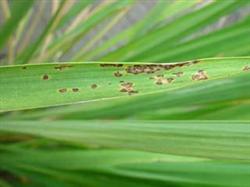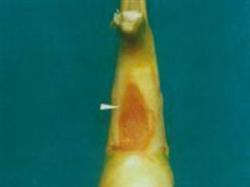Identification and control of sheath blight of Zizania caduciflora

Rhizoctonia esculenta is a common disease of Zizania latifolia, and its harm tends to be aggravated year by year. It mainly damages leaves and leaf sheaths, forming water-stained, dark green to yellow-brown cloud-like spots. At high humidity, the diseased part produced sparse light brown mycelium, and then formed early white, gradually changed to yellow brown small sclerotia. Occurrence characteristics: Pathogen for the semi-known subphylum Rhytichophyta. 25~32℃ and rainy days are favorable for the disease, and there are many sclerotia in continuous cropping soil, and the disease is serious. Control methods: ① Implement more than 3 years of rice-paddy rotation.② Reasonable dense planting; combined with farming operations such as intertillage, timely remove lower diseased leaves and yellow leaves, and improve ventilation and light transmission conditions. 3. Apply enough basal fertilizer, appropriate topdressing and more phosphorus and potassium fertilizer. 4. Spray 5% Jinggangmycin 1000 times solution and 50% carbendazim 800~1000 times solution at the early stage of disease.
- Prev

The basic process of planting rape
The basic process of planting rape
- Next

Field management techniques of Zizania caduciflora
[symptom characteristics] the soft rot of Zizania caduciflora mainly occurred in Zizania caduciflora during transportation, sale and storage after harvest. At first, the infected Zizania caduciflora showed nearly round to amorphous nearly translucent water stains, then the disease spot expanded rapidly, the affected tissue was soft rotten, smelled foul smell, and finally some or most of the tissue rotted and could not be eaten. Suffer from.
Related
- Where is it suitable to grow horseradish in China? it is expected to see the middle altitude horseradish in Alishan.
- How to prevent tomato virus disease reasonably? (Control methods included)
- Many people like to plant towel gourd on the balcony. What are the main points of this method and management?
- What crops can chili peppers be mixed with?
- Fertilization techniques and matters needing attention in Tomato
- What are the grafting techniques for peach seedlings in spring?
- Harm and control methods of root swelling disease of Chinese cabbage
- What are the pests of sweet potatoes? How to prevent and cure it?
- Symptoms, causes and Control methods of navel Rot in Tomato
- The cause of "Cucumber rotten bibcock" in Farmers' planting Cucumber and its Control Plan

